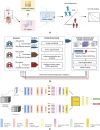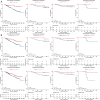Voxel-level radiomics and deep learning for predicting pathologic complete response in esophageal squamous cell carcinoma after neoadjuvant immunotherapy and chemotherapy
- PMID: 40090670
- PMCID: PMC11911808
- DOI: 10.1136/jitc-2024-011149
Voxel-level radiomics and deep learning for predicting pathologic complete response in esophageal squamous cell carcinoma after neoadjuvant immunotherapy and chemotherapy
Abstract
Background: Accurate prediction of pathologic complete response (pCR) following neoadjuvant immunotherapy combined with chemotherapy (nICT) is crucial for tailoring patient care in esophageal squamous cell carcinoma (ESCC). This study aimed to develop and validate a deep learning model using a novel voxel-level radiomics approach to predict pCR based on preoperative CT images.
Methods: In this multicenter, retrospective study, 741 patients with ESCC who underwent nICT followed by radical esophagectomy were enrolled from three institutions. Patients from one center were divided into a training set (469 patients) and an internal validation set (118 patients) while the data from the other two centers was used as external validation sets (120 and 34 patients, respectively). The deep learning model, Vision-Mamba, integrated voxel-level radiomics feature maps and CT images for pCR prediction. Additionally, other commonly used deep learning models, including 3D-ResNet and Vision Transformer, as well as traditional radiomics methods, were developed for comparison. Model performance was evaluated using accuracy, area under the curve (AUC), sensitivity, specificity, and prognostic stratification capabilities. The SHapley Additive exPlanations analysis was employed to interpret the model's predictions.
Results: The Vision-Mamba model demonstrated robust predictive performance in the training set (accuracy: 0.89, AUC: 0.91, sensitivity: 0.82, specificity: 0.92) and validation sets (accuracy: 0.83-0.91, AUC: 0.83-0.92, sensitivity: 0.73-0.94, specificity: 0.84-1.0). The model outperformed other deep learning models and traditional radiomics methods. The model's ability to stratify patients into high and low-risk groups was validated, showing superior prognostic stratification compared with traditional methods. SHAP provided quantitative and visual model interpretation.
Conclusions: We present a voxel-level radiomics-based deep learning model to predict pCR to neoadjuvant immunotherapy combined with chemotherapy based on pretreatment diagnostic CT images with high accuracy and robustness. This model could provide a promising tool for individualized management of patients with ESCC.
Keywords: Chemotherapy; Esophageal Cancer; Immunotherapy; Neoadjuvant.
© Author(s) (or their employer(s)) 2025. Re-use permitted under CC BY-NC. No commercial re-use. See rights and permissions. Published by BMJ Group.
Conflict of interest statement
Competing interests: None declared.
Figures



References
-
- Janjigian YY, Shitara K, Moehler M, et al. First-line nivolumab plus chemotherapy versus chemotherapy alone for advanced gastric, gastro-oesophageal junction, and oesophageal adenocarcinoma (CheckMate 649): a randomised, open-label, phase 3 trial. Lancet. 2021;398:27–40. doi: 10.1016/S0140-6736(21)00797-2. - DOI - PMC - PubMed
Publication types
MeSH terms
LinkOut - more resources
Full Text Sources
Medical
